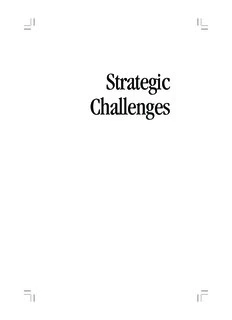
Strategic Challenges: America's Global Security Agenda PDF
Preview Strategic Challenges: America's Global Security Agenda
Strategic Challenges RELATED TITLES FROM POTOMAC BOOKS AND NATIONAL DEFENSE UNIVERSITY PRESS The Armed Forces Officer by the U.S. Department of Defense African Counterterrorism Cooperation: Assessing Regional and Subregional Initiatives edited by Andre Le Sage Seeing the Elephant: The U.S. Role in Global Security by Hans Binnendijk and Richard L. Kugler Capacity Building for Peacekeeping: The Case of Haiti edited by John T. Fishel and Andres Saenz Congress at War: The Politics of Conflict Since 1789 by Charles A. Stevenson Strategic Challenges America’s Global Security Agenda Edited by Stephen J. Flanagan and James A. Schear logo TK Institute for National Strategic Studies National Defense University Press Potomac Books, Inc. Washington, DC Copublished in the United States by National Defense University Press and Potomac Books, Inc. The opinions, conclusions, and recommendations expressed or implied within are those of the authors and do not necessarily reflect the views of the Department of Defense or any other agency of the Federal Govern- ment. This publication is cleared for public release; distribution unlimited. Por- tions of this book may be quoted or reprinted without further permission, with credit to both National Defense University Press and Potomac Books, Inc. Library of Congress Cataloging-in-Publication Data Strategic challenges : America’s global security agenda / edited by Stephen J. Flanagan and James A. Schear.— 1st ed. p. cm. Includes index. ISBN-13: 978-1-59797-120-1 (hardcopy : alk. paper) ISBN-13: 978-1-59797-121-8 (pbk. : alk. paper) 1. United States—Foreign relations—2001– 2. War on Terrorism, 2001– 3. Weapons of mass destruction—International cooperation. 4. Security, Interna- tional. I. Flanagan, Stephen J. II. Schear, James A., 1953– JZ1469.S77 2008 355'.033573—dc22 2007051455 Printed in the United States of America on acid-free paper that meets the Ameri- can National Standards Institute Z39-48 Standard. Potomac Books, Inc. 22841 Quicksilver Drive Dulles, Virginia 20166 First Edition 10 9 8 7 6 5 4 3 2 1 To Ambassador Robert B. Oakley Mentor, friend, and colleague. An exceptional leader in efforts to promote peace and security amidst the post–Cold War disorder Contents List of Illustrations ix Foreword xi LIEUTENANT GENERAL FRANCES C. WILSON, USMC Acknowledgments xiii Chapter One The Emerging Global Security Environment 1 CHARLES D. LUTES, M. ELAINE BUNN, AND STEPHEN J. FLANAGAN Chapter Two Countering Global Terrorism 20 JOSEPH MCMILLAN AND CHRISTOPHER CAVOLI Chapter Three Combating WMD Threats 61 CHARLES D. LUTES Chapter Four Protecting the American Homeland 86 THOMAS X. HAMMES, JAMES A. SCHEAR, AND JOHN A. COPE Chapter Five Defusing Conflicts in Unstable Regions 110 JAMES A. SCHEAR Chapter Six Engaging Other Major Powers 149 JOSEPH MCMILLAN, EUGENE B. RUMER, AND PHILLIP C. SAUNDERS viii STRATEGIC CHALLENGES Chapter Seven Adapting Alliances and Partnerships 203 STEPHEN J. FLANAGAN, LEO G. MICHEL, JAMES J. PRZYSTUP, AND JOHN A. COPE Chapter Eight Transforming Defense Strategy and Posture 275 CHRISTOPHER J. LAMB WITH CHARLES D. LUTES, M. ELAINE BUNN, AND CHRISTOPHER CAVOLI Chapter Nine Securing America’s Future: Progress and Perils 314 STEPHEN J. FLANAGAN Notes 347 About the Contributors 399 Index 403 Illustrations FIGURES Figure 2–1. Propaganda by Word and Deed in Anarchism and Jihadism 24 Figure 2–2. Circles of Insurgent Support 25 Figure 2–3. Violence-Legitimacy Paradox in Insurgencies 27 Figure 2–4. Major Conflicts and Tensions in the Muslim World 42–43 Figure 2–5. U.S. Foreign Operations Budget, 2001–2007 49 Figure 3–1. Challenges and Responses: The Strategic Paradigms of Weapons of Mass Destruction 63 Figure 3–2. Applying Cooperative Threat Reduction Techniques to the Global Nuclear Problem 81 Figure 6–1. Chinese Exports to World, 2004 164 Figure 6–2. Chinese Imports from World, 2004 165 Figure 6–3. Russian Gross Domestic Product Growth and Crude Oil Prices 170 Figure 6–4. Selected Oil and Gas Pipeline Infrastructure in the Former Soviet Union 178 Figure 7–1. Allied Defense Spending Trends, 1995–2005 213 Figure 7–2. Shifting South Korean Attitudes 247 Figure 7–3. Area of Notional Mexico-Caribbean Basin Surveillance System 269 Figure 8–1. Budget Risks Inherent in Current Defense Program 278 Figure 8–2. Critical Need for Information Superiority 281 Figure 8–3. Joint Concept Relationships 282 ix x STRATEGIC CHALLENGES TABLES Table 4–1. Hurricane Katrina: The Impact 99 Table 5–1. Iraq and Afghanistan: A Comparison 136 Table 6–1. Chinese Defense Spending, 2001–2006 155 Table 6–2. China’s Missile Forces 161 Table 6–3. Dependence on Imports from and Exports to China 164 Table 6–4. Comparison of Russia and the Commonwealth of Independent States 176 Table 6–5. Key Indian Military Capabilities 186 Table 6–6. Comparing the Great Powers 198 Table 7–1. U.S. Forces around the World 207 Table 7–2. U.S. and Key Ally Expenditures on Official Develop- ment Assistance and Defense, 2005 222
Description: